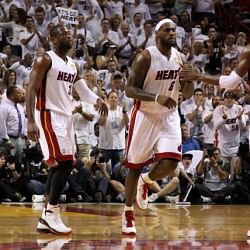
Beating the Miami Heat: Part 1
The summer of 2010 was maybe the most eventful ever in the history of the NBA. The day when two of the best players in the league decided to join hands with the league’s second best shooting guard in Dywane Wade to form a congregation that had never been envisaged. Taking one’s talent to South Beach as they said.
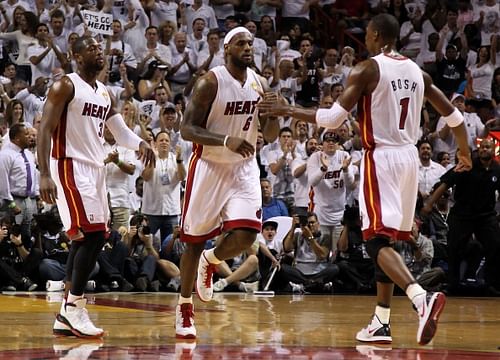
The Miami Big Three of (L-R) Dwyane Wade #3, LeBron James #6 and Chris Bosh #1. (Getty Images)
LeBron James and Chris Bosh, left as traitors to their respective franchises in Toronto and Cleveland. Both of them were franchise stars, especially LeBron who had openly stated his desire to create his legacy with the franchise. Till then he was the city’s favorite, a player they vehemently defended beyond all tirades comparing him to Kobe Bryant and Michael Jordan. Revered by the fans he was protected by the city’s media and the management who went to the greatest lengths to give him the ideal supporting cast. LeBron had a team alike to what Michael had with the Bulls, strong and suited to get his abilities and strengths to hyperbolic levels.
Micheal had Scottie Pippen, and many believed that even LeBron needed a Robin to help him be Batman. But, nobody expected Batman to leave Gotham. Well, LeBron did and that is why to the city of Cleveland he will always remain a deep anguish.
“Strength and courage aren’t always measured in medals and victories. They are measured in the struggles they overcome. The strongest people aren’t always the people who win, they are the people who don’t give up when they lose. “
A great line indeed but to the hierarchy driven basketball fraternity, greatness has always been about winning, and the challenges don’t get counted until you overcome them. Allen Iverson is thus still a bust, and so are John Stockton and Karl Malone. LeBron could have chosen the high-road but he chose to win instead; to please the savants and earn his right to a legacy mirroring the likes of the great Michael Jordan. He tried to appease, but pleasing the savants is not a given. He was castigated and ridiculed by the media for making a fool of the league’s basic need of harboring equitable franchises. Branded an escapist and a quitter — forget Batman — he was suddenly Judas.
But 8 years into the league, LeBron was also aware of the fickle nature of such pundits and he knew that with Bosh and Wade, he had a chance to take over the basketball universe and dominate it like no player ever had. As LeBron famously proclaimed in the media presentation, “ I am here to win Championships. Not one, not two, not three, not four, not five, not six, not seven.” No prizes for guessing why he stopped at 7.
Was it going to be that easy? No, because building a team isn’t as simple as just assembling players and hoping that their talents add up. They needed to find an identity, a common ground and needed to season into a championship team. Two years after a drubbing at the hands of a not-so-glamorous yet efficient Dallas team, LeBron was vindicated. Consecutive Finals wins over the OKC has now set before us a team that seems destined to make the prophecy come true. With the best record in the league and a record 23-games win-streak, one can surely try and put a ceiling on what this team can achieve.
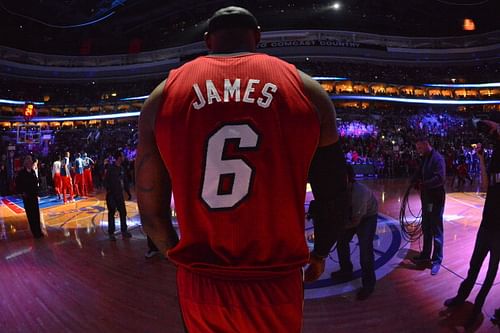
LeBron James #6 of the Miami Heat is the favourite to win the MVP award. (Getty Images)
And that brings us to the question that is most probably giving many basketball players and franchises sleepless nights. Are the Miami Heat even beatable? LeBron is playing the best basketball of his life, Wade’s improved health has seen him prove yet again that, when healthy he is still among the top 5 players in the game and Bosh has silently but surely proved to be a major match-winner. The bench and the other role-players seem to know their duties and have come up trumps whenever the situation demands. Mario Chalmers, Udonis Haslem, Shane Battier, Ray Allen, Mike Miller, Chris Anderson, Norris Cole and Rashard Lewis all seem to relish the roles and the opportunity of being a part of something so special. They make sacrifices for each other and have not so discreetly showed off their team chemistry in a rather disturbing Harlem Shake gag.
However, beyond all their extolments and histrionics beating the Heat is still very much possible. It is a tall order indeed, but over a series of 7 games there is most certainly a way to beat them.
The blueprint on how to do it at the offensive end of the floor needs to revolve around the following key-points:
1. Slowing down the tempo:
The Heat love to run the floor, to fill the lanes and to play a high-tempo transition offense. Most importantly despite what the OKC Thunder and the LA Clippers may claim, the Heat are far more dangerous and efficient on the open floor, and no team can hope to beat the Heat with a run-and-gun game. The key is to disrupt the Heat’s offense, by playing a slow tempo game. The team has to try and get the ball inside to their bigs’ and feed off them. Force the Heat defense to make adjustments and exploit their lack of length and depth inside. Execute set offensive plays from the post and attack the Miami Heat’s interior defense.
2. Careful ball movement in the paint:
The Miami Heat are among the best in the league in forcing turn-overs and earning easy transition opportunities. In fact they average around 9 steals per game to go along with 16 turnovers per game, and they feed on such lapses to get their transition and up-tempo offense flowing. The only way to beat them is by ensuring that teams take care of the basketball, avoid getting into traps and move the ball from side-to-side and force the Heat’s defense to make decisions and swift rotations. The benefit is that the Heat lack a legitimate shot-blocker and with the rim-protection being a major deficiency, the teams could look to exploit any possible lapses in the defensive rotations to earn open looks or find lanes to finish at the rim.
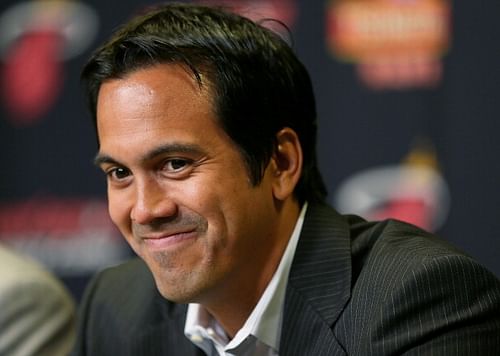
Miami Heat head coach Erik Spoelstra deserves credit for the way he has set up the Heat defense. (Getty Images)
The need is to attack the set-defense of the Heat with dribble penetration, and forcing the Heat’s defense to cover to the paint. The Heat are forced to do so because Bosh can’t be taken very seriously as a shot-blocker and with the whole team forced to react, it can surely open up opportunities for the spot-up shooters. The NY Knicks and the Milwaukee Bucks used this strategy beautifully when they beat the Heat and this seems like a sure solution to open up the rather stubborn Heat defense. The only issue is that the Heat’s wing defensive unit of Chalmers, Wade and LeBron are premier defenders and thus it is imperative that opposing teams utilize a high pick-and-roll to get to the paint and execute the dribble penetration to force the defense to collapse.
3. Perimeter shooting:
The dribble penetration and forcing the extensive defensive rotations from the Heat can only work if the teams can make their perimeter shots. The opposition needs to be prepared to take, and make open-shots. What that will do is force the Miami Heat to stick closer to their defensive assignments, and make decisions as to when and how often can they afford to rotate and try trapping or double-teaming the opposition’s ball-handlers. This shall not only open up the floor for the ball-handlers to penetrate and finish at the rim, but will make the Miami Heat defense work harder and shall take away their defense-leads-to-offense mentality.
This is indeed the only way to beat a Pat Riley system, and even though many might have scoffed at the version of Mike D’Antoni’s system (whose methods may work here, not the Lakers), it might very well be the answer to the defensive solidity of the Heat.
4. Feed the team’s bigs’ and grab more boards:
It is no secret that the Heat like to go small and that leaves them with a major weakness inside. Bosh is not a legitimate center and the back-ups of Anderson and Joel Anthony are relatively pedestrian. The Heat depend on their collective effort to bail them out time and again, and that is their biggest vulnerability. Maybe the fact that not many Eastern Conference teams have legitimate post players, help the Heat and play into their hands, but the exploits of a certain Ersan Illyasova of the Bucks or the Indiana Pacers Roy Hibbert can go a long way in showing that such vulnerabilities can be exploited to hurt the Heat. It is imperative that teams look to feed their bigs’ on the low-post and try to set them up with a quick post-up. It has to be quick, because the Heat excel in trapping players in the post, and it has to be effective. Bosh or Haslem aren’t worthy shot-blockers and once the bigs’ get to the rim, finishing is a relatively easy task.
Further on, the Heat are among the worst in the league in rebounding, and it is imperative that the opposition big-men try and earn as many second-chance point opportunities as possible. This is maybe the easiest way to hurt the Heat and eliminate the open-court game. Surely LeBron and Wade can’t hope to be making the full-court alley-oop plays when they have to fight hard just to secure a rebound.
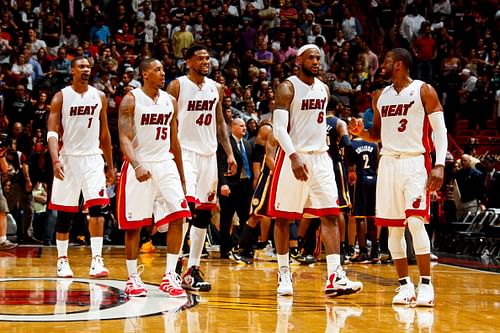
The starting 5: Miami Heat players Chris Bosh #1, Mario Chalmers #15, Udonis Haslem #40, LeBron James #6, and Dwyane Wade #3. (Getty Images)
5. Draw fouls:
The Miami Heat despite being a very aggressive defensive unit, do a great job of avoiding getting into foul trouble. This is mostly because they are swift and quick with their rotations and weak-side help, and force teams into traps and turnovers. They don’t play a lot of isolation defensive sets and mostly keep the play at the perimeter, forcing opposition teams to earn their points off difficult mid-range and perimeter jump-shots.
Opposition teams thus need to ensure that they spread out the floor, use off-ball staggered and brush screens to create some isolation mismatches and try to earn more trips to the charity stripe. That way teams play an inside-out game, force the Heat defense to try something outrageous and earn easy points at the free-throw line.
This in a nut-shell is what teams need to do to beat the Miami Heat. The fact that in 23 matches, the Heat haven’t come across any team that could execute these strategies efficiently speak volumes of their defensive ability. It is easier said than done, but if it is to be done, this is how it has to be done.
Part Two of the article, talks about what the opposition teams need to do on the defensive end of the floor to beat the Heat.